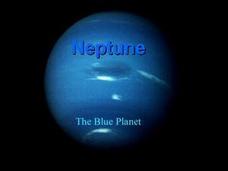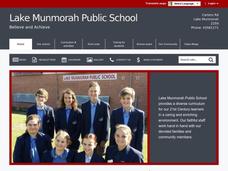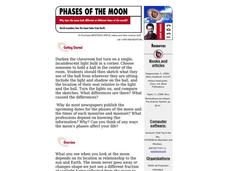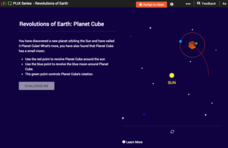Curated OER
Neptune: The Blue Planet
A lovely space science PowerPoint teaches learners about the discovery and characteristics of the planet Neptune. The slides show real photographs, along with clear descriptions about Neptune. This PowerPoint is beautifully done with...
Curated OER
Space
In this space worksheet, learners respond to 12 various questions related to the solar system, space exploration, and space facts. First, they list the number of moons each planet has. Then, students name the first space flight and who...
Curated OER
Named Moons of Saturn
In this space science worksheet, students find the words that are related to the learning of new vocabulary about the moons of Saturn. The answers are found at the bottom of the page.
Curated OER
Exploring the Planets
Sixth graders explore the planets through an interactive web site. For this astronomy based lesson, 6th graders compare planets, explore comets, and discover planet facts through a variety of activities provided by the Smithsonian Museum.
Curated OER
Solar System and Planets
Students identify the main components of the solar system. In this earth science lesson, students order the planets according to their distances from the Sun. They differentiate planets from dwarf planets.
Curated OER
Phases of the Moon
Students explore why when you examine the moon depends on its location in relationship to the sun and Earth. The moon never goes away or changes shape-we just see a different fraction of sunlight being reflected from the moon to Earth.
Curated OER
Moon: NC Summer Tour Lesson 2007
Young scholars investigate craters and marea. In this crater and marea lesson, students conduct an experiment to create craters. Young scholars participate in a dance activity.
Curated OER
Models of the Earth and Moon
Students explore the earth's rotation and phases of the moon. In this planets lesson, students rotate and revolve around a light representing the sun. Students use movement and props to simulate what causes the phases of the moon as well...
Curated OER
Exploring Dwarf Planet Eris
In this planet Eris instructional activity, students read about the discovery of this dwarf planet and its characteristics. Students answer 3 questions about the planets, the classification of planets and the definition of planets....
Curated OER
Kepler-The Hunt for Earth-like Planets
In this hunt for planets worksheet, students read about the Kepler satellite used to detect exoplanets. Students solve 6 problems including drawing a sun disk and determining the scale in kilometers/millimeter, finding the area of the...
Curated OER
Gravity Exploration
In this space instructional activity, students complete each of the statements related to weight on the moon. Then they create three questions that could be answered after completing the lab activity.
Mr. Hill's Science Website
Solar System Fact Sheet
Here is a fantastic, educational handout packed with information and facts not only about the planets in our solar system, but also regarding major moons and their surface features, dwarf planets, comets, and asteroids.
TLS Books
Neptune
Did you know that Neptune is named after the Roman god of the sea? Young astronomers read about this and other facts about the eighth planet from the sun in a short informational text passage.
Laboratory for Atmospheric and Space Physics
Space Travel Guide
Looking to take a trip? Why not go to space? Here, scholars take on the role as travel agent to create a guide to their favorite planet including travel tips and sightseeing recommendations.
Journey Through the Universe
Our Solar System
Take your class on a journey through our solar system. Learners explore each planet, from Mercury to Pluto, and discuss various features that differentiate one from another. They complete activities related to the topics and discuss the...
Curated OER
Scale Activities
How do you put something as large as the universe in perspective? Use a series of scale experiments. Classmates collaborate around four experiments to examine the scale of the earth-moon system, our solar system, the Milky Way galaxy,...
Keep it Simple Science
The Earth in Space
Skim the surface of the earth with this brief, compact, summary of outer space. The sun, stars, galaxies, planets, and phases of the moon can be found in this all-in-one resource. Seventh graders will enjoy these simple worksheets to do...
American Museum of Natural History
Planetary Mysteries
Get to know our little part of the vast universe. Learners read about the common and not-so-common facts about each of the planets in the solar system. The interactive lesson includes a large amount of information as well as a quiz to...
American Museum of Natural History
Cosmic Cookies
Scholars read about each planet then bake a plate of cosmic cookies—no-bake cookies decorated to look like the planets; Mercury, Venus, Earth, Mars, Jupiter, Saturn, Uranus, Neptune, and Pluto.
Laboratory for Atmospheric and Space Physics
Explore Saturn and Titan with Spectral Data
Titan is Saturn's largest moon and has its own atmosphere. An attention-grabbing tutorial allows learners to analyze the spectrum of Saturn and Titan to determine their elemental compositions. Scholars compare a known element's spectrum...
CK-12 Foundation
Revolutions of Earth: Planet Cube
Does assessing Earth Science vocabulary making your head spin? Test scholars' knowledge of revolving and rotating using an interactive tool. The movement of a new planet and its moon is in their hands, allowing them to explore...
Curated OER
Your Weight on Other Planets
Students explore their weight on other planets. In this science activity, students view a presentation about the other planets and complete a worksheet in which they make predictions about their weight on the moon and other planets.
Curated OER
Space: Stars and Planets
Pupils observe and report that the moon can be seen sometimes at night and sometimes during the day. They describe how changes to a model can help predict how the real thing can be altered. Students explain the essential fact of the...
Curated OER
Solar System: The Four Inner Planets and Earth's Moon and Astronauts
Second graders read THe Magic School Bus: Lost in the Solar System. For this language arts and science lesson, 2nd graders explore the four inner planets. Students view the inner planets using Google Earth.























